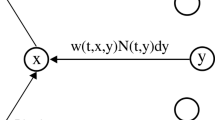Abstract
This paper proposes a model of neural networks consisting of populations of perceptive neurons, inter-neurons, and motor neurons according to the theory of stochastic phase resetting dynamics. According to this model, the dynamical characteristics of neural networks are studied in three coupling cases, namely, series and parallel coupling, series coupling, and unilateral coupling. The results show that the indentified structure of neural networks enables the basic characteristics of neural information processing to be described in terms of the actions of both the optional motor and the reflected motor. The excitation of local neural networks is caused by the action of the optional motor. In particular, the excitation of the neural population caused by the action of the optional motor in the motor cortex is larger than that caused by the action of the reflected motor. This phenomenon indicates that there are more neurons participating in the neural information processing and the excited synchronization motion under the action of the optional motor.
Similar content being viewed by others
References
Wagatsuma, H. and Yamaguchi, Y. Neural dynamics of the cognitive map in the hippocampus. Cogn. Neurodyn. 1(2), 119–141 (2007)
Igarashi, J., Hayashi, H., and Tateno, K. Theta phase coding in a network model of the entorhinal cortex layer II with entorhinal-hippocampal loop connections. Cogn. Neurodyn. 1(2), 169–184 (2007)
Wang, Rubin, Zhang, Zhikang, and Duan, Yunbo. Nonlinear stochastic models of neurons activities. Neurocomputing 51, 401–411 (2003)
Tass, P. A. Stimulus-locked transient phase dynamics, synchronization and desynchronization of two oscillators. Europhys. Lett. 59(2), 199–205 (2002)
Tass, P. A. Stochastic phase resetting of stimulus-locked responses of two coupled oscillators: transient response clustering, synchronization and desynchronization. Chaos 13(1), 364–376 (2003)
Neiman, A. B., Russell, D. F., Yakusheva, T. A., DiLullo, A., and Tass, P. A. Response clustering in transient stochastic synchronization and desynchronization of coupled neuronal bursters. Phys. Rev. E 76(2), 021908 (2007) DOI: 10.1103/PhysRevE.76.021908
Wagatsuma, H. and Yamaguchi, Y. Disambiguation of multiple sequence learning by theta phase coding. Brain & Neural Networks 12(1), 17–31 (2005)
Yamaguchi, Y., Aota, Y., Sato, N., Wagatsuma, H., and Wu, Z. Synchronization of neural oscillations as a possible mechanism underlying episodic memory: a study of theta rhythm in the hippocampus. Journal of Integrative Neuroscience 3(2), 143–157 (2004)
Tass, P. A. Phase Resetting in Medicine and Biology, Springer-Verlag, Berlin (1999)
Wang, Rubin, Zhang, Zhikang, and Yu, Jing. Mechanism of neurodynamics on attention and memory (in Chinese). Chin. J. Theor. Appl. Mech. 38(6), 816–824 (2006)
Wang, Rubin and Zhang, Zhikang. A neural model on cognitive process. Lecture Notes in Computer Science 3971, Springer, Berlin/Heidelberg, 50–59 (2006)
Jiao, Xianfa and Wang, Rubin. Synchronization in neuronal population with the variable coupling strength in the presence of external stimulus. Appl. Phys. Lett. 88(20), 203901 (2006)
Wang, Rubin and Jiao, Xianfa. A stochastic nonlinear evolution model and neural coding on neuronal population possessing variable coupling intensity in spontaneous behavior. Neurocomputing 69(7–9), 778–785 (2006)
Jiao, Xianfa. and Wang, Rubin. Nonlinear dynamic model and neural coding of neuronal network with the variable coupling strength in the presence of external stimuli. Appl. Phys. Lett. 87(81), 083901 (2005)
Jiao, Xianfa and Wang, Rubin. Synchronous firing and its control in neuronal population with time delay. Advances in Cognitive Neurodynamics, Springer, Netherands, 213–217 (2008) DOI: 10.1007/978-1-4020-8387-7_38
Wang, Rubin, Zhang, Zhikang, Xie, Zhigang, and Jiao, Xianfa. Dynamics coding of phase on multi-populations of neural oscillators (in Chinese). Journal of Dynamics and Control 7(3), 217–225 (2009)
Huang, B. X. Advanced Features and Neural Network of Brain, Science Press, Beijing (2000)
Li, Z. S. and Tu, Y. Q. Human-Simulation Intelligent Control, National Defence Industry Press, Beijing (2003)
Gu, F. J. and Liang, P. J. Neural Information Processing, Beijing Technology University Press, Beijing (2007)
Hu, Jiyong, Ding, Xin, and Wang, Rubin. Neurocognition mechanism of fabric touch sensation. Chin. J. Theor. Appl. Mech. 41(5), 757–764 (2009)
Author information
Authors and Affiliations
Corresponding author
Additional information
Communicated by Li-qun CHEN
Project supported by the National Natural Science Foundation of China (Nos. 10872068, 10672057)
Rights and permissions
About this article
Cite this article
Wang, Rb., Zhang, Zk. & Tse, C.K. Neurodynamics analysis of brain information transmission. Appl. Math. Mech.-Engl. Ed. 30, 1415–1428 (2009). https://doi.org/10.1007/s10483-009-1107-y
Received:
Revised:
Published:
Issue Date:
DOI: https://doi.org/10.1007/s10483-009-1107-y
Key words
- serial and parallel model of neural networks
- phase coding
- synchronous motion
- perception neuron
- inter-neuron
- motor neuron
- population of neural oscillators



